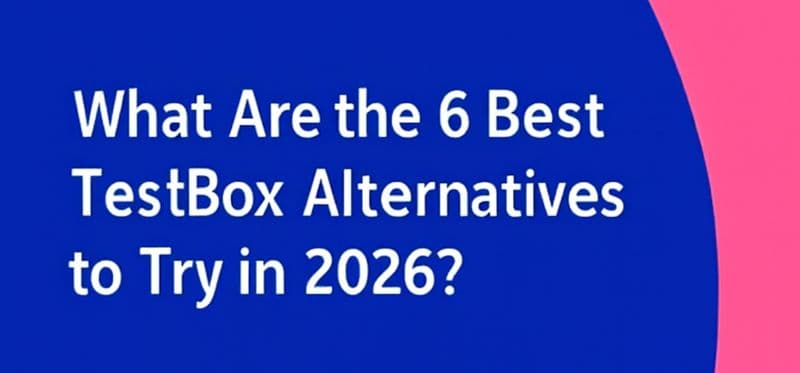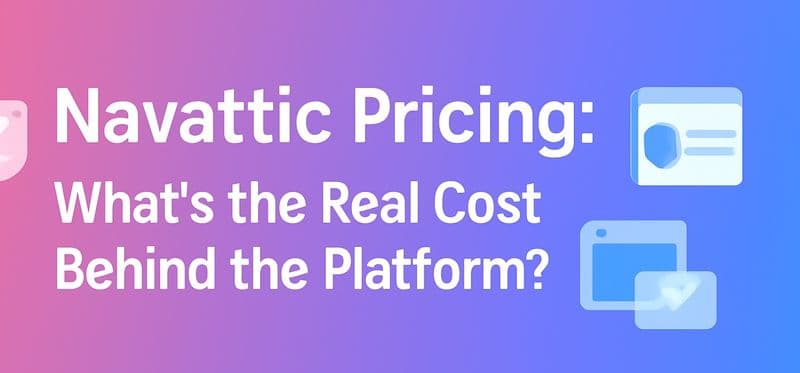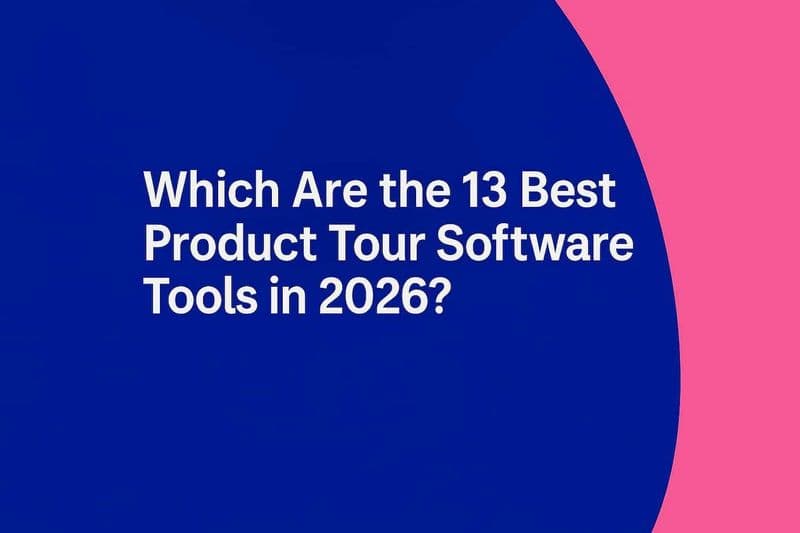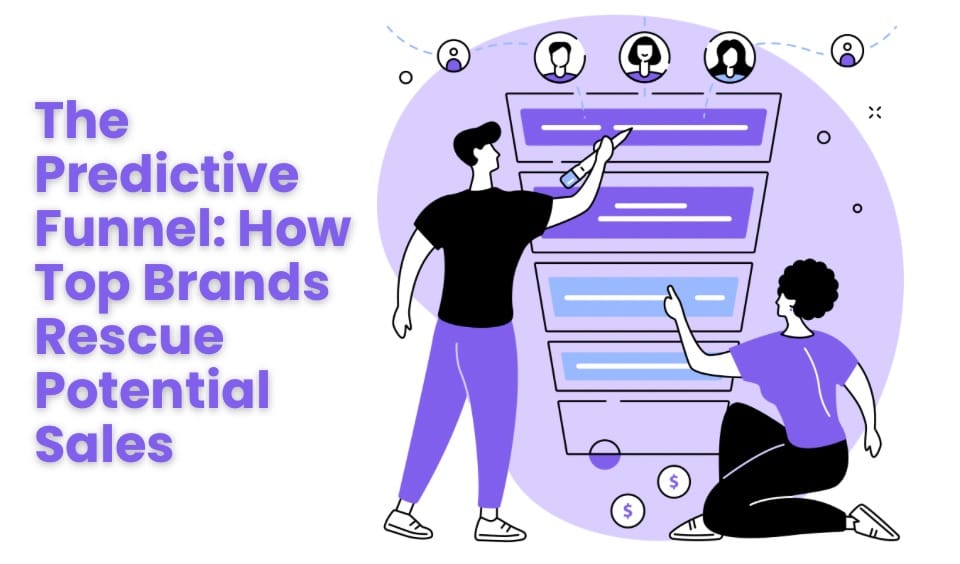
Key Highlights
Predictive funnels help sales teams anticipate customer behavior and recover potential lost sales.
AI and machine learning turn sales data into accurate predictions and smarter engagement.
Funnel analysis identifies drop-offs, boosts predictive accuracy, and drives higher conversions.
Each stage of the predictive funnel, from awareness to retention, builds on real-time insights.
A data-driven framework helps teams automate actions and refine strategies continuously.
Clean data, human insight, and full-funnel optimization keep predictions sharp and relevant.
Predictive funnels evolve with every interaction, learning and improving over time.
The future of sales lies in prediction, prevention, and precision-driven growth.
We’ve all been there. Leads are pouring in, your campaigns look solid, and the sales funnel feels full, until it isn’t. Somewhere between interest and action, those “ready-to-buy” prospects quietly vanish. It’s like running a restaurant where half the customers read the menu, smile politely, and walk out before ordering.
At first, we blame the usual culprits: bad timing, weak follow-ups, maybe a competitor swooping in at the worst moment. But the truth is simpler (and a little painful): most of us are reacting instead of predicting. We chase every lead the same way, relying on gut instinct and hoping something lands. Meanwhile, potential deals slip through unnoticed.
That’s where predictive funnels flip the script. They take the guesswork out of sales by spotting patterns we can’t see. Using real data, they reveal who’s ready to buy, who needs more time, and who’s already gone cold. In this blog, we’ll break down how predictive funnels work, how top brands use them to recover lost sales, and how you can build one that keeps your pipeline from leaking in the first place.
What Is a Predictive Sales Funnel and How Does It Work?
A predictive sales funnel is a smarter, more adaptive version of the traditional funnel. Instead of reacting after leads drop off, it helps your sales team anticipate which prospects are most likely to buy and take action before they disappear. It’s about being proactive, not reactive.
At its core, a predictive funnel uses artificial intelligence, machine learning, and predictive analytics to analyze customer data, study behavior patterns, and forecast outcomes. It helps sales leaders and reps understand what drives each stage of the funnel so every interaction, message, or follow-up happens at the right time.
Here’s how it works in practice:
Data collection: The system gathers information from multiple sources, such as social media, email campaigns, CRM tools, and marketing automation platforms.
Pattern recognition: It analyzes historical data to identify what actions and signals move prospective customers from the top of the funnel to the next stage.
Predictive scoring: Advanced analytics determine which leads are most qualified based on engagement, pain points, and intent.
Automated action: It then triggers the next move automatically, like sending a follow-up email, alerting sales reps, or adjusting a campaign to better fit the target audience.
The difference between a traditional sales funnel and a predictive one is simple: the old model reports what already happened, while the predictive model helps you shape what happens next.
By learning from real customer behavior, it gives both your marketing team and sales pipeline the clarity to act faster, engage smarter, and convert more effectively.
How Does Funnel Analysis Turn Data Into Higher Conversions?
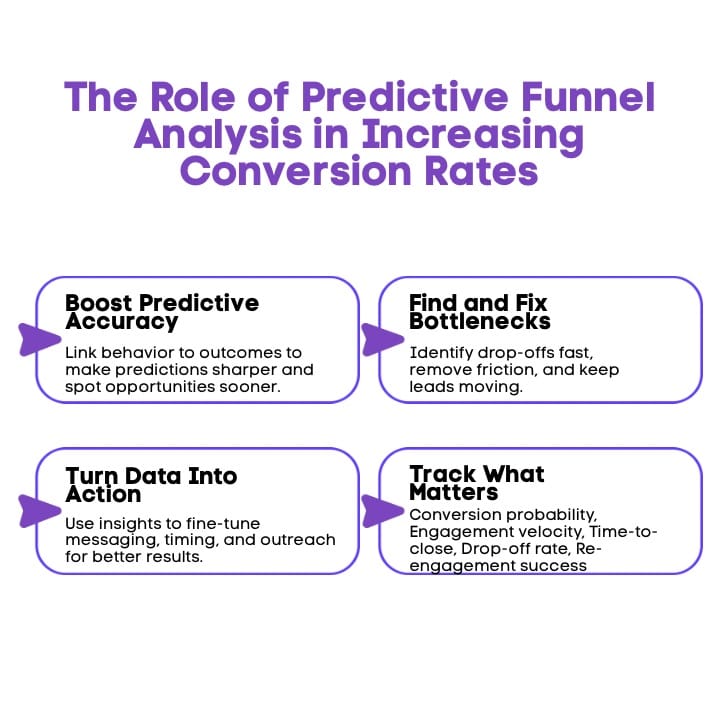
Ever watched leads pour into your funnel only to vanish halfway through? It’s like users signing up for a free trial but never logging in again; the interest was there, but something in the journey broke the connection. That’s where funnel analysis comes in. It shines a light on every stage, showing where prospects stall, why they drop, and how to keep them moving.
In short, funnel analysis turns confusion into clarity. It reveals how leads actually move through the sales funnel and what changes can turn hesitation into conversion.
Here’s how it helps sharpen your predictive strategy and boost results.
1. Connecting Funnel Analysis and Predictive Accuracy
Predictive accuracy depends on how well you understand your funnel. Funnel analysis helps you connect the dots between behavior and outcome, revealing when people engage, where they lose interest, and what triggers action. These insights make your predictive models smarter and your sales team faster at spotting opportunities before they fade.
2. Finding Bottlenecks and Drop-Off Points
Every slowdown tells a story. Maybe leads stop after downloading a free trial or never respond after a pricing email. Funnel analysis uncovers those sticking points so your sales and marketing teams can act early. By seeing exactly where engagement dips, you can fix friction before it turns into lost revenue.
3. Turning Data Into Actionable Adjustments
Knowing the problem is one thing. Acting on it is another. Funnel analysis gives you the data-backed confidence to adjust messaging, personalize outreach, and time follow-ups with precision. Instead of pushing harder, you start selling smarter, matching each step to real customer intent.
4. Track What Matters
Track the numbers that reveal what’s really happening inside your funnel:
Conversion probability
Engagement velocity
Time-to-close
Drop-off rate
Re-engagement success
Funnel analysis doesn’t just explain where leads go, but it also helps you keep them. When every move is guided by insight, your team doesn’t chase conversions; they create them.
What Are the Main Stages of a Predictive Sales Funnel?
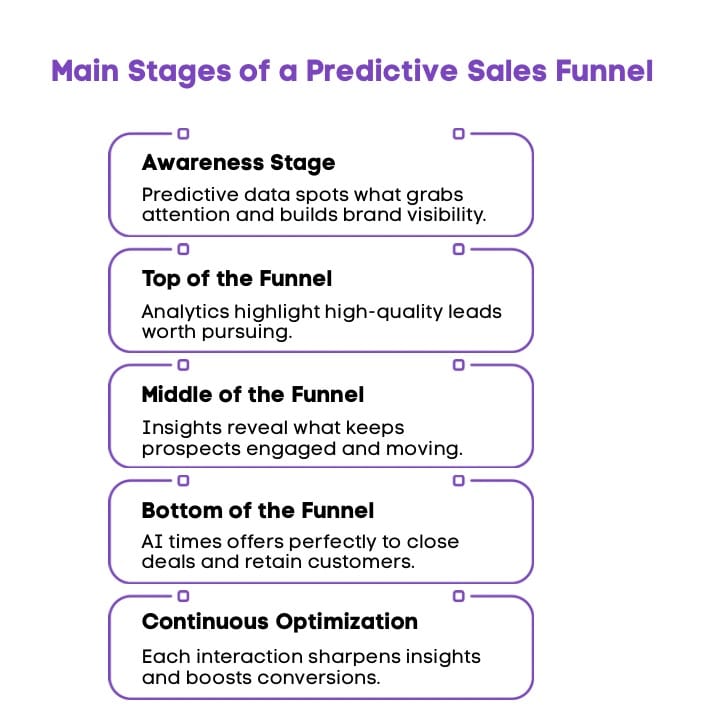
Every funnel has stages: awareness, engagement, and conversion. But in a predictive funnel, each stage talks to the next. Data flows, patterns emerge, and your team doesn’t just react to what customers do; they stay one step ahead.
1. Predicting Awareness and Reach
This is where people first notice your brand. Predictive insights help you see what’s working before you even ask. By tracking early signals from marketing campaigns, digital marketing efforts, and social media, you learn which messages grab attention and build real brand awareness among your ideal customers.
2. Forecasting Lead Quality at the Top of the Funnel
Here’s where curiosity turns into potential. Predictive analytics studies customer behavior and market trends to identify who’s worth pursuing. Instead of treating every click as equal, it highlights the most qualified leads, the ones who actually fit your customer base and align with your business goals.
3. Anticipating Engagement in the Middle of the Funnel
Now it’s all about engagement. Predictive models read customer interactions and email responses to gauge intent. They show you what content lands, when interest fades, and what kind of follow-up keeps people moving. Think of it as insight that meets timing: every nudge based on data, not guesswork.
4. Optimizing Conversions at the Bottom of the Funnel
This is where deals close and relationships begin. Predictive tools surface the right offer at the right time and help your sales team address objections before they even come up. After conversion, the focus shifts to customer retention, using automation and personalized outreach to strengthen the customer experience and build loyalty that lasts.
5. Continuously Refining Predictions Through Optimization
Predictive funnels don’t stop when a sale closes. Every win, loss, and click feeds the next cycle, refining what works and what doesn’t. Over time, you get sharper insights, higher conversion rates, and a sales process that practically learns on its own.
Building Your Own Predictive Funnel: A Step-by-Step Framework
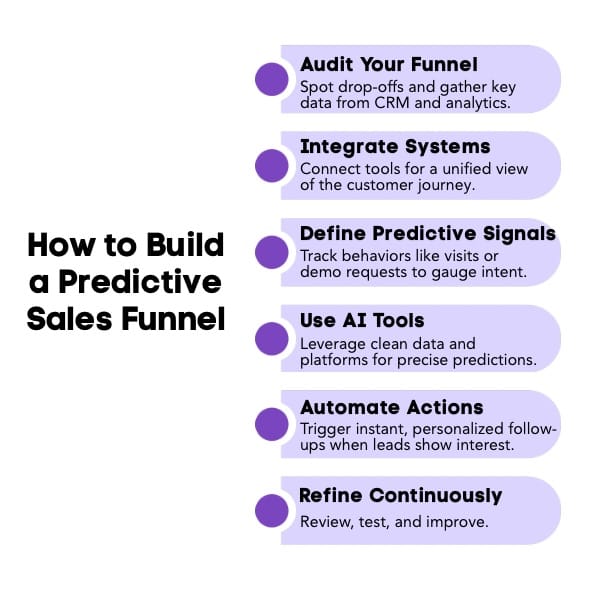
A predictive funnel isn’t something you buy off the shelf; it’s something you build, refine, and evolve as your business grows. The goal is to turn your existing sales process into a learning system that gets smarter with every interaction. Here’s how to make that happen.
1. Audit Your Current Funnel
Start by taking a hard look at what you already have. Where are leads coming from? Which channels perform best? Where do prospects drop off? Identify your main data sources, like CRM, website analytics, social media, email campaigns, and pinpoint weak spots that limit visibility or slow down conversions.
2. Integrate Analytics and CRM Platforms
Your data shouldn’t live in silos. Connect your analytics tools with your CRM so your sales team has one unified view of every prospect’s journey. This integration allows predictive models to access richer, more reliable data, and helps sales reps see what’s really driving conversions instead of guessing.
3. Define Key Predictive Signals
Predictive accuracy starts with the right signals. Look for behaviors that consistently show purchase intent or risk, like repeat site visits, pricing page clicks, demo requests, or inactivity after a trial. These become the “early indicators” your predictive model uses to forecast which leads are warming up and which ones are cooling off.
4. Train Your Predictive Model or Use AI Tools
You can build your own model using machine learning or rely on AI-powered tools like HubSpot, Salesforce Einstein, or MadKudu. Either way, feed your model with clean, structured sales data and historical performance trends. The better your data, the sharper your predictions.
5. Automate Responses
Once your system knows what to look for, let it act on those insights automatically. Trigger personalized nudges, follow-up emails, or retargeting ads the moment a lead shows intent. This keeps your funnel responsive and ensures your prospects get attention at the right time, without waiting on manual follow-ups.
6. Test, Measure, Refine
A predictive funnel isn’t static; it’s a feedback loop. Keep testing your assumptions, measuring results, and refining your models. Each campaign, sale, or drop-off teaches you something new about customer behavior. Over time, your funnel doesn’t just predict outcomes, but it improves them.
Building a predictive funnel is about connecting data, technology, and timing. When all three align, you don’t just react to what’s happening; instead, you start shaping what happens next.
What Mistakes Can Derail Your Predictive Funnel?
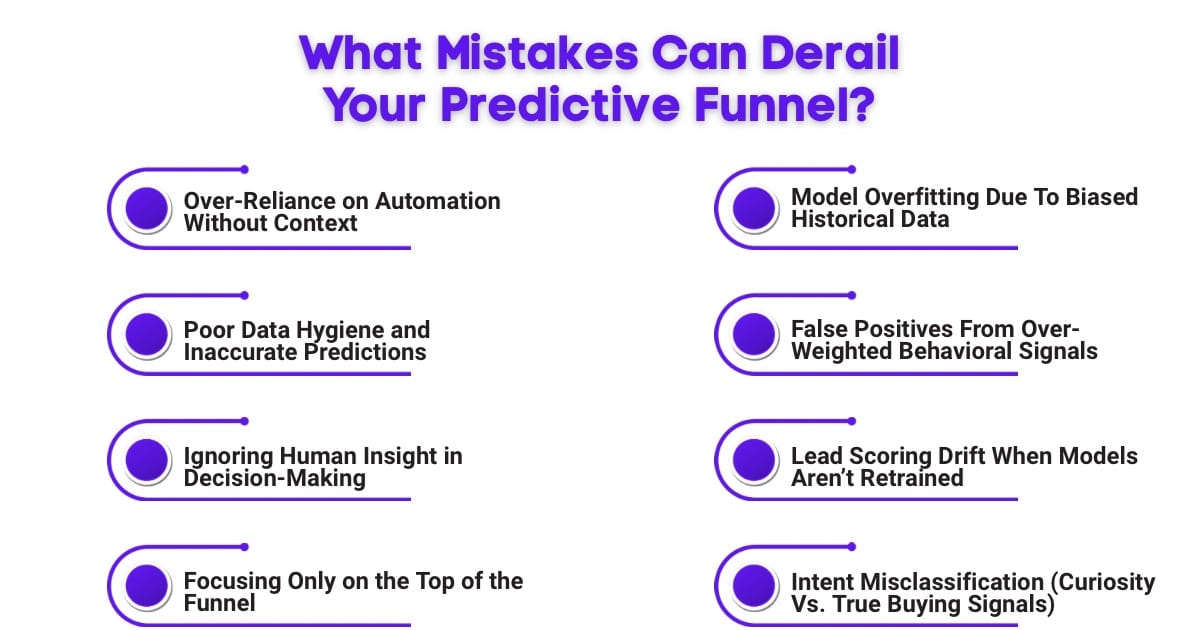
Even the smartest predictive funnel can fall flat if the foundation isn’t right. The goal isn’t just to automate, but to understand, predict, and act with context. Here are a few common traps that can quietly derail your efforts.
1. Over-Reliance on Automation Without Context
Automation is powerful, but it’s not a substitute for human judgment. Predictive systems can flag intent, but they don’t understand emotion, urgency, or nuance. When teams rely too heavily on automation, they risk sending robotic follow-ups or irrelevant messages that hurt engagement. Use automation to scale your efforts, not replace real connections.
2. Poor Data Hygiene and Inaccurate Predictions
Predictive models are only as strong as the data they’re trained on. Outdated records, duplicate entries, or missing fields can easily distort your results. Poor data hygiene leads to false positives, wasted effort, and missed opportunities. Regularly clean and validate your sales data so your predictions stay sharp and trustworthy.
3. Ignoring Human Insight in Decision-Making
AI can analyze patterns, but it can’t fully capture customer intent the way a seasoned rep or sales leader can. Human intuition still matters, especially in complex deals. Combine machine-driven insights with on-the-ground feedback from your sales team. The blend of data and experience is what turns predictions into meaningful action.
4. Focusing Only on the Top of the Funnel
Many teams make the mistake of using predictive tools just to boost lead generation, ignoring the rest of the sales cycle. But conversion doesn’t end when a lead enters the funnel. Predictive insights should guide the entire journey, from awareness to retention. The real power of prediction lies in optimizing every stage, not just the first one.
5. Model Overfitting Due To Biased Historical Data
When predictive models lean too heavily on past performance, they risk overfitting to old patterns. This creates blind spots for new customer behaviors or market shifts. Continuously retrain models with fresh, diverse data to keep predictions adaptive and future-ready.
6. False Positives From Over-Weighted Behavioral Signals
Not every action signals buying intent. When models assign too much importance to shallow engagement, like a single site visit or demo click, they can flag unqualified leads as high priority. Balance behavioral signals with contextual and demographic data to avoid wasted effort.
7. Lead Scoring Drift When Models Aren’t Retrained
As buyer behavior evolves, models trained months ago can lose accuracy. This “drift” causes once-reliable lead scores to misrepresent actual interest. Regular retraining ensures your scoring logic aligns with current sales cycles and engagement trends.
8. Intent Misclassification (Curiosity Vs. True Buying Signals)
Predictive tools sometimes confuse curiosity for commitment. A prospect exploring your product out of interest may get tagged as sales-ready, leading to premature outreach. Calibrating your intent model with qualitative insights prevents false engagement triggers and keeps outreach relevant.
Turn Predictive Insights Into Real Conversions With SmartCue
Predictive analytics can tell you who’s ready to buy, but turning that intent into action takes the right experience. That’s where SmartCue bridges the gap.
SmartCue helps sales and marketing teams create interactive product demos that engage, educate, and convert. Instead of static slides or generic videos, it shows prospects exactly how your product solves their problems, tailored to their specific needs and behavior.
With SmartCue’s engagement analytics, you can see how prospects interact with your demos, which features capture attention, and where interest drops. These insights feed directly into your predictive funnel, helping refine your messaging and outreach for stronger conversions.
SmartCue turns prediction into action by helping prospects see value faster.
Try SmartCue free for 14 days!
Final Thoughts: What’s The Future of Predictive Sales Funnels?
Predictive funnels are evolving fast. The next wave isn’t about gathering more data; it’s about connecting it across every customer touchpoint.
AI will play a bigger role in sales forecasting and personalization, shifting teams from reaction to anticipation. Soon, predictive systems won’t just highlight deals likely to close, but they’ll also flag churn risks, suggest next-best actions, and help sales reps step in before problems arise.
The real impact will come when predictive insights merge with customer success, marketing automation, and revenue operations. One connected view of customer intent turns prediction into prevention, and prevention into precision growth.
So what’s next?
Start building your predictive foundation now. Clean your data, connect your systems, and embrace continuous learning. In the next era of sales, foresight isn’t a bonus; it’s the new definition of readiness.
Frequently Asked Questions
Which AI tools are best for creating sales funnels?
Tools like HubSpot, Salesforce Einstein, and MadKudu are top choices for predictive funnels. They combine sales analytics, lead scoring, and marketing automation to identify qualified leads, improve customer engagement, and guide prospects smoothly through every stage of the funnel.
What is predictive sales analysis?
Predictive sales analysis uses data analysis, machine learning, and behavioral modeling to forecast outcomes within the sales process. It helps teams gain valuable insights into customer needs, optimize sales strategies, and align marketing efforts with future sales opportunities for stronger overall performance.
How can AI be used to predict sales?
AI studies customer interactions, historical data, and sales trends to make accurate predictions about buying intent. By analyzing these patterns, sales leaders can generate actionable insights that enhance revenue growth, refine sales performance, and improve decision-making at every level of the funnel.
Are predictive sales funnels suitable for both B2B and B2C businesses?
Yes. Predictive funnels adapt to both B2B and B2C sales models by analyzing customer journey data, tailoring messaging, and identifying ideal customers. Whether targeting businesses or individuals, AI-driven prediction delivers higher conversion rates and improved customer satisfaction.
Can predictive funnel analytics help identify which leads are most likely to convert?
Absolutely. Predictive analytics evaluates engagement signals, lead scoring, and behavioral trends to spot the potential customer most likely to buy. It helps sales teams focus their marketing campaigns on the right prospects, improving efficiency and overall customer experience.
How does predictive analysis enhance the accuracy of sales funnels?
Predictive analysis enhances funnel accuracy by turning raw data into meaningful insights. It pinpoints which marketing strategies work best across the awareness stage, middle of the funnel, and bottom of the funnel, helping teams adapt quickly to market changes and strengthen brand awareness.
How does AI impact long-term customer retention?
AI helps teams nurture relationships beyond the sale through personalized follow-ups, email marketing, and smart recommendations. These best practices build trust, maintain engagement, and ensure the customer base stays loyal, creating measurable improvements in long-term customer retention and satisfaction.
